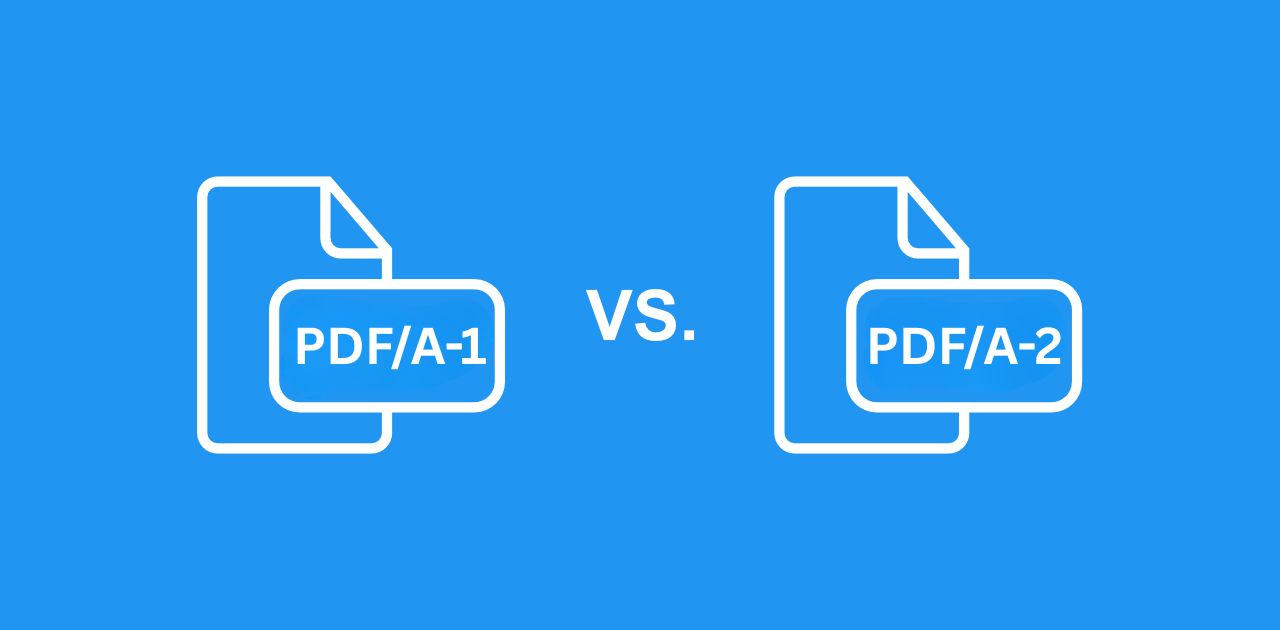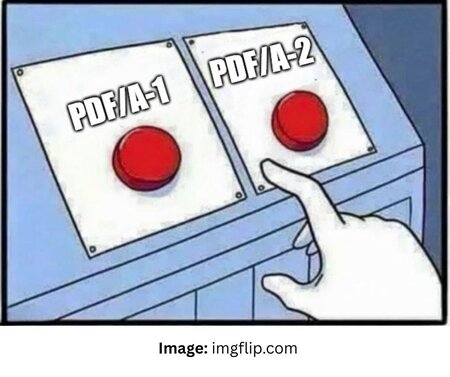
When preparing documents for long-term archiving, choosing the right PDF/A standard is essential. On PDF2Go, the "Convert PDF to PDF/A" tool lets you select from several options — including PDF/A-1A, PDF/A-1B, PDF/A-2A, PDF/A-2B, and PDF/A-2U. But what do these versions mean?
What's the difference between PDF/A-1 and PDF/A-2? And which one should you choose?
What is PDF/A?
PDF/A is a specialized version of the PDF format, designed for long-term archiving and digital preservation. First published by the ISO in 2005, its main goal is to ensure that documents remain viewable and consistent — no matter how technology evolves.
PDF/A ensures that your document:
- Is fully self-contained (no external fonts or links)
- Looks the same on any device or software in the future
- Is accessible, especially for people with visual impairments
PDF/A-1: The Original Standard
PDF/A-1 is based on the PDF 1.4 specification. It includes the essential features for long-term archiving, such as:
- Ensuring consistent visual appearance
- Embedding fonts
- Supporting basic metadata and accessibility
You can choose:
- PDF/A-1A: Full accessibility and document structure (great for screen readers and tagging)
- PDF/A-1B: Focuses on visual preservation only (smaller file size, faster processing)
📌 Best for: Simple documents that don't require advanced features like transparency, layers, or embedded files.

PDF/A-2: The Advanced Option
Released in 2011, PDF/A-2 builds on PDF 1.7 and introduces new features that modern users might need. This version is not a replacement for PDF/A-1 — but an alternative for those who want extra flexibility.
Key enhancements in PDF/A-2:
- Transparency support (drop shadows, highlights, etc.)
- JPEG2000 compression (better for color-rich scans and images)
- Embedded file collections (grouping multiple PDFs, like email + attachments)
- Optional content layers (useful for maps or multilingual manuals)
- Improved digital signature support
- New conformance level: PDF/A-2U — enables Unicode text searching and copying
- Updated Comments and Annotations - Expands the range of allowable annotation types (like text editing comments) while maintaining archival reliability.
- Object-Level XMP Metadata - Adds support for custom metadata at the object level — enabling advanced categorization and automation in document management systems.
You can choose:
- PDF/A-2A: Accessible and fully structured (best for compliance)
- PDF/A-2B: Focuses on visual preservation
- PDF/A-2U: Adds Unicode support for better search and copy features
📌 Best for: Complex documents, scanned files, or anything requiring enhanced archiving features.
Quick Comparison Table
| Feature | PDF/A-1 | PDF/A-2 |
|---|---|---|
| Based on PDF version | 1.4 | Up to 1.7 / ISO 32000-1 |
| Transparency | ❌ Not supported | ✅ Supported |
| JPEG2000 compression | ❌ Not supported | ✅ Supported |
| Embedded PDF collections | ❌ Not supported | ✅ Supported |
| Optional content (layers) | ❌ Not supported | ✅ Supported |
| Digital signatures | ✅ Basic support | ✅ Improved interoperability |
| Unicode conformance level | ❌ Not available | ✅ PDF/A-2U |
Do You Need to Upgrade from PDF/A-1 to PDF/A-2?
Not necessarily. PDF/A-1 documents are valid and reliable for archiving. However, if your documents benefit from features like transparency, layers, or Unicode support — PDF/A-2 is the better choice.
👉 PDF/A-3 adds support for embedding non-PDF files like XML, CSV, or other formats, making it ideal when you need to archive both documents and accompanying data files.
PDF2Go allows you to select the PDF/A level that fits your needs!
How to Convert PDF to PDF/A with PDF2Go?
- Visit the Website: Choose Convert PDF to PDF/A tool.
- Upload your file: Click "Choose File" to upload your PDF. You can also drag and drop the file into the box. Alternatively, you can upload a file via URL or from cloud storage services like Google Drive or Dropbox.
- Select your PDF/A format: Choose the format you want to convert to – PDF/A-1, PDF/A-2, or PDF/A-3.
- Start the conversion: Click the "START" button to begin converting your file.
- Download your file: Once the conversion is complete, download your new PDF/A file.
In Conclusion
Understanding the difference between PDF/A-1 and PDF/A-2 helps you choose the right format for your document archiving needs. While PDF/A-1 is still widely supported and perfectly suitable for many use cases, PDF/A-2 offers valuable improvements.
With PDF2Go's – Convert PDF to PDF/A tool, selecting the right standard and converting your documents is simple, fast, and accessible—whether you're preserving scanned files, legal documents, or digital records for the long term. Give it a try today!
Can I Validate PDF/A?
Yes, you can! PDF2Go also offers a PDF/A validator to check if your files meet the required archiving standards.
👉 Learn more about PDF/A validation here.

